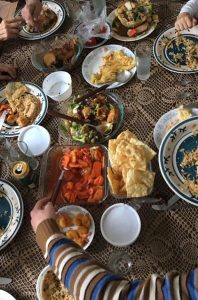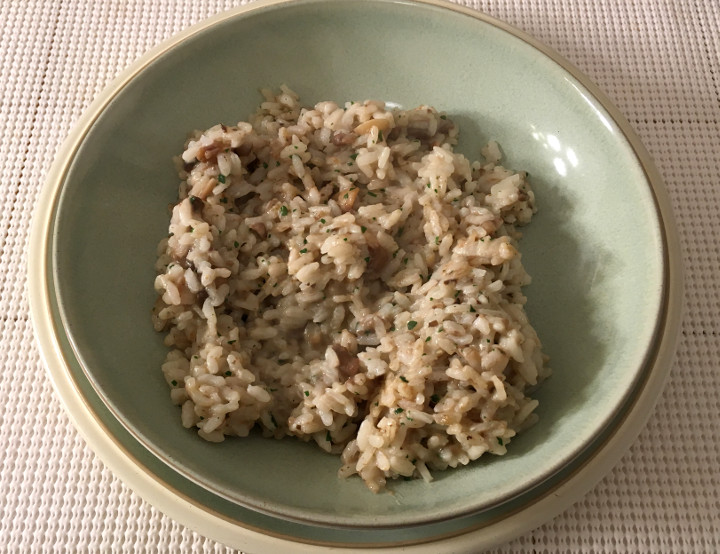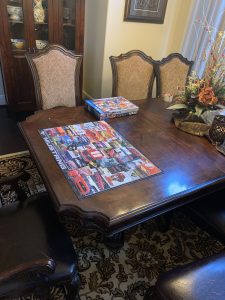Of varying shapes and sizes, the kitchen table is a universal symbol of gathering, socializing, and, most importantly, eating. While the food served on these tables may provide insight into a culture, how the culture’s kitchen table is utilized before, during, and after meals can also provide valuable information about the beliefs and values held by the culture as well. Despite being ethnically South Korean, due to living in the United States for over 15 years of my life and having parents who believed that the most important aspect of food culture was the food itself, I was never properly informed or made aware of the cultural aspects that came with the usage of the Korean kitchen table. Therefore, the purpose of this study will be to learn the usage of a traditional South Korean kitchen table, specifically my grandma’s, before, during, and after a meal and afterwards analyzing what I have learned to identify any potential South Korean cultural values and beliefs.
What particularly interested me to conduct this study about my grandmother’s kitchen table is the fact that this particular kitchen table had been used by my mother before me, along with her older sister, younger sister, and younger brother, and therefore has been around for over 40 years. It is also worth noting that my grandmother and grandfather on my mom’s side of the family still lives in the same house my mom and her siblings grew up in, in Busan, South Korea. This, in combination with using the same kitchen table, indicated to me that the traditions held there withstood the test of time, and would best represent the cultural traditions and beliefs that were associated with the South Korean kitchen table. The most fascinating aspect of my grandmother’s kitchen table is that it, unlike most tables in the United States that are heavy and locked into one position of the room, my grandmother’s table is portable due to being light and having all four of its legs being able to be tucked beneath it. As such, it does not see much usage until it is time to eat. In terms of physical characteristics, the table is rectangular, can sit approximately six people, and is composed of a red wood of unknown origin, and coated with a protective covering that makes it sleek and shiny. It is not elevated like most tables used in the United States, and has a low profile, requiring people to sit on the floor around it. On the four sides of the table is an engraving depicting an old traditional Korean parade, with a king and queen marching along a road with their horses and servants.
The main anthropological methods I used to conduct my study was an interview with my grandma over the phone, as well as comparison of the information from the interview. As I am currently about 7,200 miles away from Busan, South Korea, where my grandmother currently resides, the interview method was made due to convenience. The comparison method was used to draw important generalizations based on the information given through the interview, especially among different genders and age groups, to identify potential cultural values, and to make cross-cultural comparisons to Chinese and Italian cultures learned in class. To ease my grandmother, the interviewee, into the interview, I let my grandma know personally that I was an “American-country boy,” basically a novice of traditional Korean traditions, and was looking forward to learning from an expert. This was to ensure she was free to talk about every aspect of the kitchen table a question demanded. I also eased her into answering the questions by saying that she could recall stories of any recent or past family gathering or meal that involved the table. The interview itself was organized into three parts, the beginning with the table usage before the meal, then during the meal, and finally after the meal. Each part was roughly 20 minutes. The questions asked in each part were open-ended and mostly specific to the particular stage of the meal (before, during, after). Specific questions that were asked in all three parts of the interview included where the table was situated during that particular stage of the meal, and any specific roles men and women had during that stage of the meal.
Before the meal, the table would be in the kitchen, completely unfolded, as the older women, which included my aunt, my mom, and my grandma, prepared the setup for the meal. The order of the setup on the table typically involved placing the utensils, the metal spoon and chopsticks, on the table first. My grandma mentioned that she and my grandpa would have a special pair of gold-colored utensils placed at the supposed head of the table, where they would sit, with everyone else having regular silver-colored ones. The food would go on the table as they were ready, with dishes of banchan, or Korean side dishes, and bowls of cooked rice going on first while the main dish, usually some form of stew, large plate of fish, or Korean barbeque, going on the center of table last as they usually take longer. My grandma specifically mentioned that seafood was more often than not the centerpiece of the table and also constituted a majority of the banchan than other kinds of dishes, citing sea urchins, soy marinated crab, and odeng (fish cake) as some of the common side dishes, and grilled mackerel, seafood soup, and grilled hair tail fish as some of the common main dishes. Sometimes, when vegetables or fruit needed to be cut or peeled and not enough room is available in the sink, this process occurs at the table before any food is set. When I asked about role the men and children play before a meal, my grandma said that they usually relax in the living room by talking or watching TV.
During the meal, the table is usually carried by the men, usually my uncle, dad, or grandpa, to be set in the living room area, while the women either finish preparations on the main dish or move to the living room to join them. After everyone is seated, no one touches even their chopsticks until the grandparents, at the head of the table, lifted theirs. Then everyone says, “thanks for the food,” and digs in. At this time the table becomes a social hub, full of energy from the stories, laughter, and even competition as children rush to eat the best side dishes and parts of the main course before their cousins and siblings. My grandma specifically recalled a story about how my mom, when she was in elementary school, would often steal her siblings’ odeng off their rice bowl when they were looking away. Moms would sometimes help young children who were not yet used to using utensils yet eat, often exchanging their chopsticks for a simpler fork. Adults would also transfer food to children and young adults at the table, telling them to “eat a lot.” Most food on the table, with the exception of individual bowls of rice and soup, are shared among those present at the table. After most of the food was eaten, one of the women would bring cups and a large jug of water for everyone to “wash down” the food.
After the meal, the women would move the table back to the kitchen, where the dishes, bowls and utensils were taken indiscriminately off the table and washed. Again, the men and children would relax by sitting in the living room, continuing conversation or watch TV while the women cleared the table. After the dishes were done, the table would be wiped clean with a wet cloth, have its legs folded, and tucked into a corner of the kitchen, silently awaiting the next meal.
Through an hour-long period of questioning and reminiscing with my South Korean grandma about the long traditions of her kitchen table, I was able to conclude some major aspects of South Korean culture, and the kitchen table as a cultural artifact. Through a comparison of gender roles in the preparation and cleaning of the table, the women are responsible for both the setting up and the cleaning up the table, which indicates that South Korea is traditionally a patriarchal society, where the women are responsible for the cooking and cleaning while the men tend to not associate with the kitchen at all, as they are expected to work to provide for the family outside the home. This is also reflected in Italian culture in the excerpt that was shown in class from the BBC show Two Greedy Italians, where the women supposedly, “look after the house and do all the cooking,” while the “men relax,” which is a nearly identical separation of labor that was described to me about South Korean kitchen culture. Additionally, the ritual of having separate utensils for the elders and not eating until the grandparents do shows that South Korean culture is rooted in having the utmost respect for elders. This respect for the elderly, most likely stemming from Chinese Confucian beliefs, shows an acceptance of cultural values from China to Korea, potentially through interactions such as trade in the early days of the nation. Finally, the fact that most of the common dishes present on my grandma’s table are seafood shows that the kitchen table serves as a canvas on which to paint information about a culture’s geographic location. In this case, Busan is a city close to the sea, and therefore the abundance of seafood on the table reflects the numerous seafood markets and shops that would result from being close to the sea. Therefore, the interview I had with my grandma displays the kitchen table as a cultural artifact worthy of study, representing the beliefs, history, and even the geographical location that influenced the formation of the culture.







